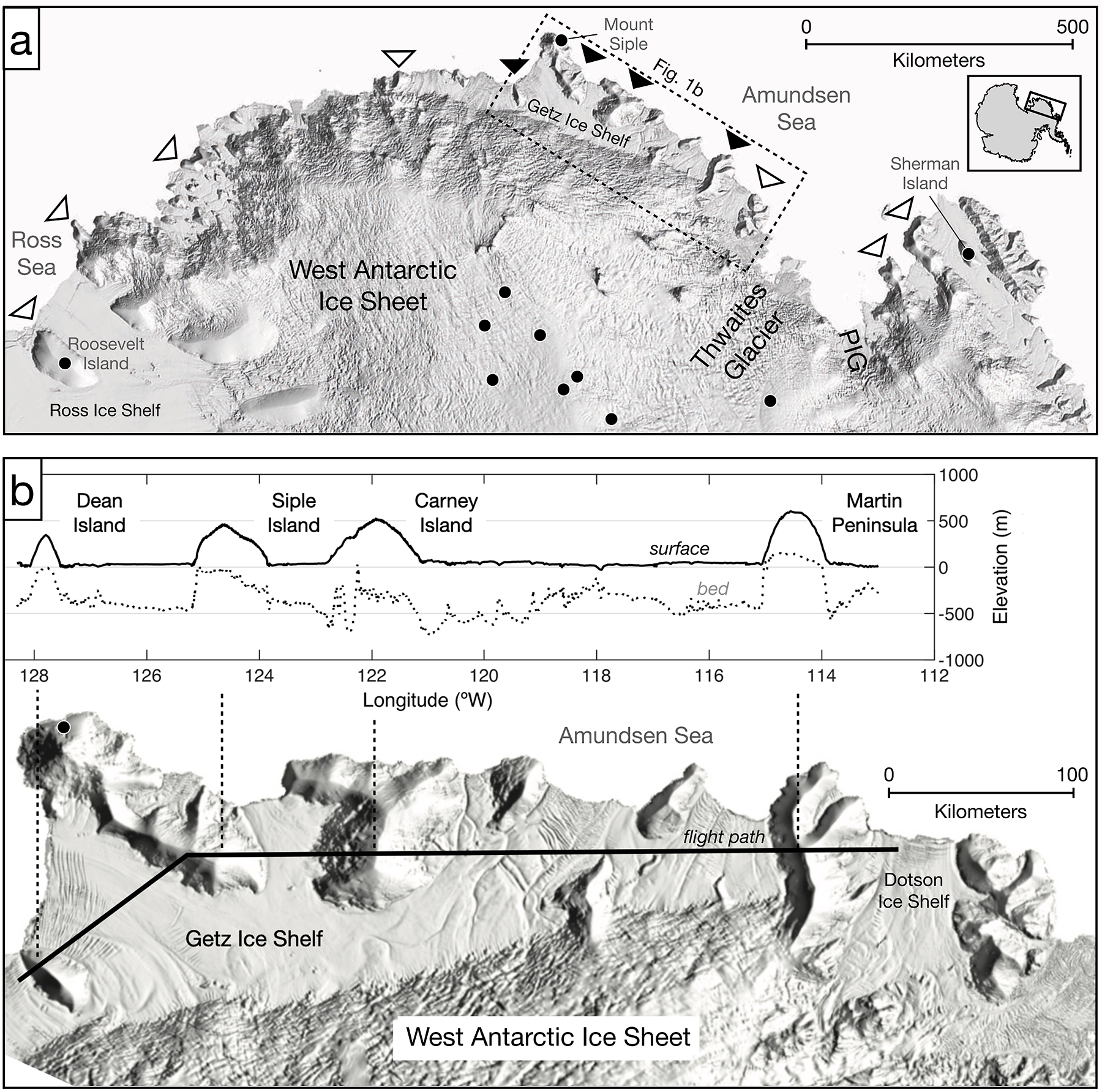Full Text
How much sea level rise will come from Antarctica’s ice loss and how quickly will it arrive at coastlines worldwide? These are the key questions for scientists seeking to improve projections of sea level rise through gathering of myriad new geophysical, geological, oceanographic, atmospheric, and paleoclimate data.
The Amundsen Sea sector of West Antarctica (~90°W to 130°W) is losing ice at an accelerating rate (Shepherd et al., 2018) through basal melting of ice shelves linked to atmosphere-ocean processes. In a phenomenon first identified by oceanographic and remotely sensed observations in the mid-1990s, it is now established that regional winds drive upwelling of warm, nutrient-rich Circumpolar Deep Water onto the Amundsen Sea continental shelf via glacially carved bathymetric troughs. These troughs focus this relatively warm water beneath ice shelves and at glacial grounding lines, particularly those of Pine Island Glacier, Thwaites Glacier, and Getz Ice Shelf (Jacobs et al., 2012). However, our understanding of these ice-ocean-atmosphere interactions is fundamentally limited in time and space.
Circum-Antarctic weather observations begin during the International Geophysical Year of 1957–58, and spatiotemporally complete climate reanalysis data sets become reliable after 1979. Remotely sensed observations of ice flow and surface elevation begin in the early 1990s, as do Amundsen Sea oceanographic observations. Thus, regional records of climate and ice sheet behavior are limited to a 30-year time span, making observations ineffective for capturing longer-term ocean and ice sheet variability (Steig and Neff, 2018). This lack of knowledge of Amundsen Sea boundary conditions prevents evaluation of model results that suggest recent ice loss is related to regional winds, which have strengthened through the twentieth century, possibly related to anthropogenic warming (Holland et al., 2019). In order to understand the emergence of such trends and confirm anthropogenic linkages, a longer observational perspective is needed.
Ice cores provide the primary extension of our spatiotemporal view of the modern Antarctic environment through continuous, annually dated proxy records that span recent decades, centuries, and millennia (Steig et al., 2013; Thomas et al., 2017). Most Antarctic ice cores have been recovered from the slow-flowing ice sheet interior (Figure 1a) in areas ideal for preserving stratigraphy and that avoid the complexities of coastal climate, including warmer temperatures, orographic effects, faster ice flow, high snowfall, and crevassed transitional zones. A growing number of ice cores have been recovered from coastal ice rises, domes, ridges, promontories, or islands, including Law Dome, Siple Dome, Berkner Island, Fletcher Promontory, Roosevelt Island, Skytrain Ice Rise, and Sherman Island.
|
|
Ice rises are like miniature ice sheets that fringe the larger Antarctic continent. They are independently flowing accumulations of snow and ice grounded on bedrock highs, often within or at the margin of ice shelves. Ice rises are targeted for coring because, despite their coastal locations, they retain relatively simple domed stratigraphy and slow ice flow speed, they have high snow accumulation rates that yield thick annual layers, they are elevated above ice shelves prone to surface melt, they interact with coastal and ice-shelf processes, and their internal structure can record past ice flow dynamics (see Matsuoka et al., 2015).
Along the Amundsen Sea coast, ice rises up to 800 m thick (Figure 1a,b) are bombarded by cyclonic storms, resulting in high annual snow accumulation rates, often in excess 0.5 m ice-equivalent on windward aspects (NASA Operation IceBridge snow radar data, not shown). Thick layering increases temporal resolution but reduces the age of ice preserved at depth. Here, mere kilometers from the ocean, a 100 m ice core may record at least a century beyond modern observations, while deeper cores to bedrock may record thousands of years of regional environmental history. Because ice rises are less than 1,000 m thick, basal melting is limited and Pleistocene-age ice may be preserved where geothermal heating is minimal.
Due to the remote location of the Amundsen Sea coast, its notoriously foul weather and ocean conditions, and the complexities of interacting ice, ocean, and atmospheric dynamics, fieldwork here requires international, interdisciplinary collaboration, such as the ongoing US-UK International Thwaites Glacier Collaboration. However, the paleoclimate rewards likely exceed the logistical risks. From existing near-coastal records, we know that sodium, chloride, and methanesulfonic acid present in ice enable reconstructions of wind strength and sea-ice/polynya conditions, while water stable isotopes reliably reflect temperature and moisture source (Steig et al., 2013), and snow accumulation records reveal spatiotemporal trends in ice sheet surface mass balance driven by the competition of low and high pressure systems in the Ross-Amundsen and Bellingshausen Seas, respectively (Thomas et al., 2017). Two short ice cores, collected in 2017 from Mount Siple and in 2020 from Sherman Island (Elizabeth Thomas, British Antarctic Survey, pers. comm., 2020; Figure 1a), contain multidecadal records that will provide scientists a first glimpse into the utility of Amundsen Sea coastal ice rises for centennial to millennial paleoclimate reconstructions.
To improve our ability to model past and present ice shelf and ice sheet behavior in the dynamic Amundsen Sea sector and beyond, scientists need direct high-resolution paleoclimate records of regional decadal- to millennial-scale atmospheric and oceanic conditions (Jacobs et al., 2012). Previously unstudied coastal ice rises, proximal to the Amundsen Sea, may contain such records. Better understanding of this remote yet globally relevant region is urgently needed to ensure that realistic, actionable sea level projections are available and usable for risk assessments and adaptation plans as society seeks to build resilience for the hundreds of millions of people populating coastal communities worldwide.


